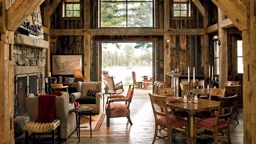To Thom Filicia, creating a sustainable, health-minded home isn’t an overnight process. The interior designer, TV star and author is on the board of the Sustainable Furnishings Council and says it’s all about embracing what he calls “shades of green.”
“It doesn’t have to happen with every piece,” he says. “I call it ‘shades of green’ because we’re all easing into it, we’re all learning about it and we’re all figuring it out.”
With a little bit of shopping savvy, it’s possible to incorporate Thom’s happy, healthy ideas into every square foot of your home, from the fine details to fabulous furnishings. Here’s how to find your shade of green:
Start Small
Where to start? Thom advises to begin with the small purchases you make every day for your home. Think: hand soap, detergent, light bulbs and household cleaners. “These are all easy, everyday items that we need to replenish consistently,” Thom explains. “At this point, there are really great, really responsible products out there that you can buy at all the big-box stores.”
Look for ENERGY STAR-certified LED light bulbs and cleaners with simplified ingredient lists. Shop brands with lower-waste packaging or refillable and reusable systems.
“It’s not only better for the world, it’s better for you,” Thom says. “Those little practices make a big difference. It’s an interesting code to live by.”
Get Low
Step things up by going low-VOC. Thom advises renovators and decorators shop for paints, adhesives and finishes that are low in or free of volatile organic compounds, which are released as gases and, according to the EPA, have harmful effects on human health in the long and short term.
“When it comes to decor, first and foremost, start with the paints that we choose to bring into our homes and the glue that we choose for the wallcoverings,” Thom says. “All of those things can now be low-VOC and are available in all the major stores. That’s a really easy way to start having less chemicals bouncing off the walls in your house.”
For log and timber homeowners, plenty of the most popular stains and finishes more than meet this criteria, and brands like Structures Wood Care and Perma-Chink Systems boast low-VOC formulas.
Rest Easy
Thom proves going green is so easy, you can do it in your sleep. “When you’re upgrading your bedding or your mattress, look at whether they’re using organic, recycled materials. Shop for recycled-cotton or organic-cotton bedding,” he advises. “They come in all the same fabulous colors, so you’re not limited.”
Try brands like Pact, Boll & Branch and West Elm for bedding sets that are chic and certified.
Reduce and Reuse
Don’t forget this classic approach still applies. Something doesn’t need to be new with certifications on the label to be a green choice. Look for furniture that is recycled, vintage or antique. Take it one step further and repaint or reupholster it to cater to your style. It can be as simple as a fresh coat of (low-VOC) paint on a timeless treasure.
An added benefit: Curating furnishings this way adds character and creates a collected-over-time look, perfect for the timeless vibe of log and timber homes. “I love a mix of traditional and modern and vintage and antique,” Thom says. “I love bringing all those things together and creating your own look. Bringing in vintage pieces that are recycled and reused, repainting and reupholstering them with organic or repurposed fabrics and organic foams and low-VOC paint ... you won’t believe the huge difference that makes.”
Study Up
Thom points out that a little research goes a long way, as industry standards and options change daily.
“Information is changing pretty consistently as companies see that there are new ways to do things and there are new materials to work with,” he says. “As we’re speaking, people are making decisions today that are going to affect products tomorrow.”
Don’t be afraid to ask questions, and remember that labels like “organic” may have different qualifications outside the U.S. When deciding on a product, Thom says start by finding out:
- Where did it come from?
- What are the regulations there?
- What are the qualifications for any certifications it boasts?
The Sustainable Furnishings Council offers a full list of questions on their website.
“I think reading the label is key and starting to understand which consumer brands are holding up their end of the bargain is important,” he says. “It’s a case-by-case, store-by-store kind of thing.”
Look for labels that give credibility to claims of sustainability via third-party certification.
- GOTS: The Global Organic Textile Standard sets requirements for the ecological and social impacts of textile processing and the organic fiber content of various materials.
- OEKO-TEX: With a mission to “create trust in textiles and leather and in their production,” OEKO-TEX standards ensure a wide variety of products are safe for both people and planet.
- FSC: Described by the Sustainable Furnishings Council as the “gold standard” in wood certification, the Forest Stewardship Council sets standards for responsible forest management.
Go Slow
Finally, Thom encourages today’s homeowner to embrace the shades of green that work best within his or her budget, aesthetic and timeline.
“Along the way, I think we all might make some mistakes and not always make the best choices. But making even a choice that’s 50 percent better — or even 10 percent better — that’s a step in the right direction,” he says. “It’s okay to make a mistake. It’s better to move in the right direction than to be afraid of getting involved.”













